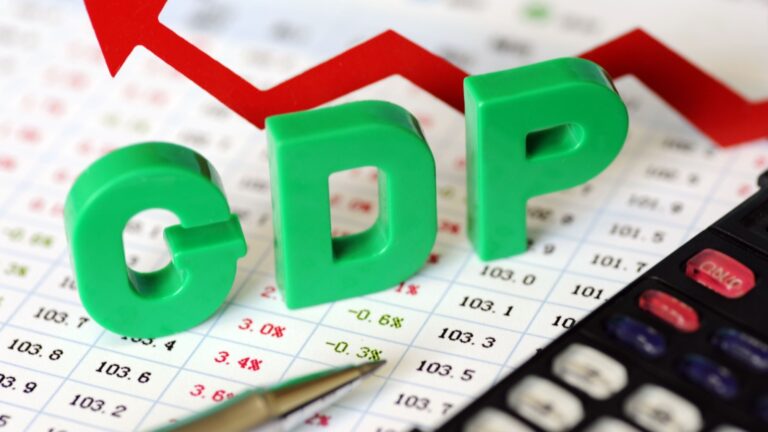Real GDP growth, a crucial measure of economic activity by the U.S. Bureau of Economic Analysis, is vital for the financial projections made by Federal Reserve Board members and Bank presidents. GDP estimates are often released during or after Federal Open Market Committee (FOMC) meetings, guiding policymakers. The Fed Board staff’s projections, known for their accuracy, are prepared for these meetings, aiding policymakers with reliable advance estimates.
GDP likely grew less than 3% in Q1, driven by strong productivity growth. The March Personal Consumption Expenditure (PCE) deflator will be revealed in the GDP report. Inflation in both PCE and CPI has risen notably, but it’s uncertain if this signals a sustained uptick or temporary factors.
This upcoming GDP report is expected to be released on Thursday, April 25, and will provide key macroeconomic data economists, analysts and investors will rely on for positioning moving forward. The data can move markets, and we’re seeing similar moves with other labor and inflation readings, so I’d expect to see any sort of hot GDP report turn out to be a negative catalyst for the market.
As of April 16, GDPNow estimates Q1 2024 real GDP growth at 2.9%, up from 2.8% the day before. Following housing starts and industrial production reports, Q1 real personal consumption expenditures and gross private domestic investment estimates rose.
Optimistic Forecasts
Productivity data can be unpredictable, but if another quarter of around 2.0% growth is seen, it would suggest an upturn in productivity. That could push the year-over-year growth rate above 3.0%, though more data is needed for certainty. Productivity growth is crucial for inflation; a 2.0% rate allows for a 4.0% nominal wage growth, meeting the Fed’s inflation target.
Consumption expenditures likely grew over 3.0%, driven by service consumption surpassing goods consumption. However, service consumption remains below pre-pandemic levels, with notable air travel and finance growth. Durable and nondurable goods consumption was weak, possibly damaging, due to slow car sales and lower prescription drug and gas sales.
Nonresidential investment surged in 2023, led by a 16.9% increase in structures, particularly factory construction. However, that growth slowed this year, with more moderate growth expected. Investment in intellectual products is picking up due to the end of strikes in the motion picture industry, with movie and TV production returning to normal.
Other Factors to Consider
When it comes to residential construction, metrics have been stable and have shown modest growth since the second half of 2023 — until now. Analysts expect the trend to rise more this Q1. High interest rates significantly slowed housing starts in 2022, resulting in a backlog of homes due to supply chain issues, significantly affecting multifamily units.
Trade, a minor net contributor to growth in the past seven quarters, is expected to decrease the growth rate slightly in the first quarter. That is mainly due to a significant increase in imports of capital goods and automobiles. However, there remains a positive trade balance in petroleum products.
The personal saving rate is expected to be around 4.0% for the quarter, down from both pandemic peaks and pre-pandemic rates of about 6.5%. However, this drop is likely due to measurement errors. In recent years, GDP measured on the income side has been slightly higher than GDP on the output side, but this trend has reversed recently.
Whether income has been understated or output overstated, the true saving rate is likely about 2.0 percentage points higher than reported, nearing pre-pandemic levels.
Stockpiling is set to boost our 2024 growth forecast by almost 50 basis points. Businesses faced tight lending, affecting their inventory levels, but a low inventory-to-sales ratio should offset this. However, stock building remains to be determined in its contribution to growth, making the forecast challenging.
The economy has been seeing some cooling down moments, meaning labor demand will also decrease. However, unemployment rates could push through 4.3% by the end of next year.
Inflation Revision
With firmer demand, inflation edged up slightly, but the increase was still moderate compared to earlier. The core PCE price index, excluding food and energy, rose at a 2.1% pace, slightly above the initial 2.0% rate.
Last quarter’s core inflation, slightly above the Fed’s 2% target, was driven by higher housing costs. Economists mostly maintained their forecasts for January PCE inflation, expecting acceleration due to larger-than-expected consumer, producer and import price increases.
The increase in inflation, leading financial markets to delay rate-cut expectations to June from May, was driven by price rises at the start of the year. Economists anticipated core PCE inflation to have risen by 0.4% in January, possibly rounding up to 0.5%. In December, the core PCE price index increased by 0.2%.
Conrad DeQuadros of Brean Capital noted a shift in spending towards final demand in Q4, potentially lifting Q1 growth forecasts. Despite the Atlanta Fed’s 3.2% GDP rise projection for Q1, some economists are cautious about January’s weak economic data.
As business spending has been rising, this only shows a contraction. That means consumer confidence has also declined, and future economic outlook concerns are looming.
Bottom Line
Expected to rise about 2.5% this year, the U.S. economy is driven by its robust labor market. However, this anticipation may just be overly optimistic. Despite a strong finish in 2023 with 3.1% growth, a slowdown to 1.8% is projected by the end of 2024.
Although a recession in the next year seems less probable, the fading effects of consumer spending, government outlays and restrictive monetary policy could limit growth.
The quarter will appear strong overall, though there were concerns about inflation. However, the report might support fears of inflation resurgence. On the positive side, there are indications of more robust productivity growth, which could alleviate inflation concerns.
On the date of publication, Chris MacDonald did not hold (either directly or indirectly) any positions in the securities mentioned in this article. The opinions expressed in this article are those of the writer, subject to the InvestorPlace.com Publishing Guidelines.

